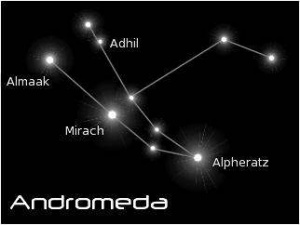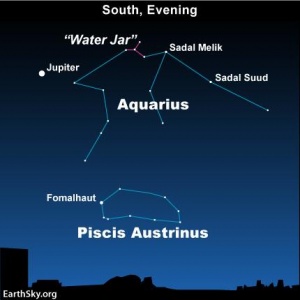Constellations in the Night Sky
From YoungHerculesWiki
⧼monobook-jumptonavigation⧽⧼monobook-jumptosearch⧽
- Probably part of the "Star Navigation" classes at Cheiron's Academy, the following constellations were mentioned as the cadets were studying for their exams.
- More info and pictures To Be Added...
Andromeda
- Mentioned by Lilith in 1.32 - Cram-Ped.
- Meaning: The Chained Woman
- Andromeda is one of the 48 constellations listed by the 2nd-century Greco-Roman astronomer Ptolemy and remains one of the 88 modern constellations. - Wikipedia
- Mythology: Andromeda is known as "the Chained Lady" or "the Chained Woman", refering to Andromeda's role in the Greco-Roman myth of Perseus, in which Cassiopeia, the queen of Ethiopia, bragged that her daughter was more beautiful than the Nereids, sea nymphs blessed with incredible beauty. Offended at her remark, the nymphs petitioned Poseidon to punish Cassiopeia for her insolence, which he did by commanding the sea monster Cetus to attack Ethiopia. Andromeda's panicked father, Cepheus, was told by the Oracle of Ammon that the only way to save his kingdom was to sacrifice his daughter to Cetus. She was chained to a rock by the sea but was saved by the hero Perseus, who used the head of Medusa to turn the monster into stone; Algol, the "Demon Star", marks the head of Medusa. Perseus and Andromeda then married; the myth recounts that the couple had nine children together – seven sons and two daughters – and founded Mycenae and its Persideae dynasty. After Andromeda's death Athena placed her in the sky as a constellation, to honor her. Several of the neighboring constellations (Perseus, Cassiopeia, Cetus, and Cepheus) also represent characters in the Perseus myth. It is connected with the constellation the pegasus. - Wikipedia
Aquarius
- Mentioned by Pincus in 1.32 - Cram-Ped.
- Meaning: The Water-Bearer
- Aquarius is one of the 48 constellations listed by the 2nd-century Greco-Roman astronomer Ptolemy and remains one of the 88 modern constellations. Aquarius is one of the oldest of the recognized constellations along the zodiac, situated between Capricornus and Pisces. It is found in a region often called the Sea due to its profusion of constellations with watery associations such as Cetus the whale, Pisces the fish, and Eridanus the river. - Wikipedia
- Mythology: In the Greek tradition, the constellation became represented as simply a single vase from which a stream poured down to Piscis Austrinus. In Greek mythology, Aquarius is sometimes associated with Deucalion, the son of Prometheus who built a ship with his wife Pyrrha to survive an imminent flood. They sailed for nine days before washing ashore on Mount Parnassus. Aquarius is also sometimes identified with beautiful Ganymede, a youth in Greek mythology and the son of Trojan king Tros, who was taken to Mount Olympus by Zeus to act as cup-carrier to the gods. Neighboring Aquila represents the eagle, under Zeus' command, that snatched the young boy; some versions of the myth indicate that the eagle was in fact Zeus transformed. An alternative version of the tale recounts Ganymede's kidnapping by the goddess of the dawn, Eos, motivated by her affection for young men; Zeus then stole him from Eos and employed him as cup-bearer. Yet another figure associated with the water bearer is Cecrops I, a king of Athens who sacrificed water instead of wine to the gods. - Wikipedia
Aquila
- Mentioned by Iolaus and Lilith in 1.32 - Cram-Ped.
- Meaning: The Eagle
- Aquila is one of the 48 constellations listed by the 2nd-century Greco-Roman astronomer Ptolemy and remains one of the 88 modern constellations. - Wikipedia
Aries
- Mentioned by Pincus in 1.32 - Cram-Ped.
- Meaning: The Ram
- Aries is one of the 48 constellations listed by the 2nd-century Greco-Roman astronomer Ptolemy and remains one of the 88 modern constellations. - Wikipedia
Auriga
- Mentioned by Lilith in 1.32 - Cram-Ped.
- Meaning: The Charioteer
- Auriga is one of the 48 constellations listed by the 2nd-century Greco-Roman astronomer Ptolemy and remains one of the 88 modern constellations. - Wikipedia
Boötes
- Mentioned by Lilith in 1.32 - Cram-Ped.
- Meaning: The Herdsman
- Boötes is one of the 48 constellations listed by the 2nd-century Greco-Roman astronomer Ptolemy and remains one of the 88 modern constellations. - Wikipedia
Camelopardalis
- Mentioned by Lilith in 1.32 - Cram-Ped.
- Meaning: The Giraffe
- The constellation was introduced in 1612 (or 1613) by Petrus Plancius. Some older astronomy books give an alternative spelling of the name, Camelopardus. First attested in English in 1785, the word camelopardalis comes from Latin, and it is the romanisation of the Greek "καμηλοπάρδαλις" meaning "giraffe", from "κάμηλος" (kamēlos), "camel" + "πάρδαλις" (pardalis), "leopard", due to its having a long neck like a camel and spots like a leopard. - Wikipedia
Cancer
- Mentioned by Pincus in 1.32 - Cram-Ped.
- Meaning: The Crab
- One of the twelve constellations of the zodiac. Cancer is one of the 48 constellations listed by the 2nd-century Greco-Roman astronomer Ptolemy and remains one of the 88 modern constellations. - Wikipedia
- Mythology: The creation of the constellation is explained in Greek mythology by the short-lived association of the crab Karkinos with one of the Twelve Labors of Hercules, in which Hercules battled the multi-headed Lernaean Hydra. Hera had sent Karkinos to distract Hercules and put him at a disadvantage during the battle, but Hercules quickly dispatched the crab by kicking it with such force that it was propelled into the sky. Other accounts had Karkinos grabbing onto Hercules' toe with its claws, but Hercules simply crushed the crab underfoot. Hera, grateful for Karkinos' effort, gave it a place in the sky. Some scholars have suggested that Karkinos was a late addition to the myth of Hercules in order to make the Twelve Labors correspond to the twelve signs of the Zodiac. - Wikipedia
Canes Venatici
- Mentioned by Iolaus in 1.32 - Cram-Ped.
- Meaning: The Hunting Dogs
Corona Borealis
- Mentioned by Gregor and Hercules in 1.32 - Cram-Ped.
- Meaning: The Northern Crown
- Corona Borealis is one of the 48 constellations listed by the 2nd-century Greco-Roman astronomer Ptolemy and remains one of the 88 modern constellations. - Wikipedia
Cygnus
- Mentioned by Iolaus in 1.32 - Cram-Ped.
- Meaning: The Swan
- Cygnus is one of the 48 constellations listed by the 2nd-century Greco-Roman astronomer Ptolemy and remains one of the 88 modern constellations. - Wikipedia
Delphinus
- Mentioned by Iolaus in 1.32 - Cram-Ped.
- Meaning: The Dolphin
- Delphinus is one of the 48 constellations listed by the 2nd-century Greco-Roman astronomer Ptolemy and remains one of the 88 modern constellations. - Wikipedia
Draco
- Mentioned by Gregor and Hercules in 1.32 - Cram-Ped.
- Meaning: The Dragon
- Draco is one of the 48 constellations listed by the 2nd-century Greco-Roman astronomer Ptolemy and remains one of the 88 modern constellations. - Wikipedia
Polaris
- Mentioned by Gregor and Hercules in 1.32 - Cram-Ped.
- Also mentioned by Ares in 1.47 - Mila - in Mila's dreams, he poses as her father and tells her to follow Polaris to find him.
- Meaning: The North Star
- Polaris is the brightest star in the constellation Ursa Minor. It is very close to the north celestial pole, making it the current northern pole star. - Wikipedia
Pegasus
- Mentioned by Gregor and Hercules in 1.32 - Cram-Ped.
- Meaning: The Winged Horse
- Pegasus is one of the 48 constellations listed by the 2nd-century Greco-Roman astronomer Ptolemy and remains one of the 88 modern constellations. - Wikipedia
Ursa Major
- Mentioned by Gregor, Pincus, and Iolaus in 1.32 - Cram-Ped.
- Meaning: The Great Bear
- Ursa Major is one of the 48 constellations listed by the 2nd-century Greco-Roman astronomer Ptolemy and remains one of the 88 modern constellations. - Wikipedia
Ursa Minor
- Mentioned by Gregor in 1.32 - Cram-Ped.
- Meaning: The Little Bear
- Ursa Minor is one of the 48 constellations listed by the 2nd-century Greco-Roman astronomer Ptolemy and remains one of the 88 modern constellations. - Wikipedia

